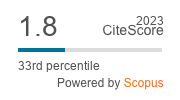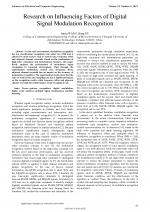| 4/2019 - 8 |
Research on Influencing Factors of Digital Signal Modulation RecognitionWANG, J. |
| View the paper record and citations in |
| Click to see author's profile in |
| Download PDF |
Author keywords
pattern recognition, digital modulation, higher order statistics, multiple signal classification, machine learning
References keywords
modulation(21), recognition(13), order(12), communications(12), signal(9), digital(8), cumulants(8), classification(8), automatic(7), signals(6)
Blue keywords are present in both the references section and the paper title.
About this article
Date of Publication: 2019-11-30
Volume 19, Issue 4, Year 2019, On page(s): 65 - 72
ISSN: 1582-7445, e-ISSN: 1844-7600
Digital Object Identifier: 10.4316/AECE.2019.04008
Web of Science Accession Number: 000500274700007
SCOPUS ID: 85077254689
Abstract
In the real environment, modulation recognition has low classification recognition rate under low SNR and is affected by many factors such as symbol rate, frequency offset and adjacent channel crosstalk. Based on the combination of high-order cumulants and instantaneous features, this paper firstly analyzes the performance of modulation signal recognition in Gaussian environment. Then through the experimental verification, symbol rate, frequency offset, adjacent channel crosstalk has an impact on the accuracy of modulation recognition. The experimental results show that the ratio of symbol rate and sampling rate has a significant impact on the recognition results, while frequency offset and adjacent channel crosstalk have little impact on the recognition rate. |
| References | | | Cited By «-- Click to see who has cited this paper |
| [1] T. Liu, Y. Guan, Y. Lin, "Research on modulation recognition with ensemble learning," EURASIP Journal on Wireless Communications and Networking, vol. 179, no. 1, 2017. [CrossRef] [Web of Science Times Cited 40] [SCOPUS Times Cited 48] [2] L. Zhang, "Research on modulation recognition algorithm based on high-order cumulant," Journal of Information Engineering University, vol. 18, no. 4, pp. 403-408, 2017. [CrossRef] [3] J. J. Guo, H. D. Yin, L. Jiang, "Recognition of digital modulation signals via high-order cumulants," Communications Technology, vol. 47, no. 11, pp. 1255-1260, 2014. [CrossRef] [4] A. Swami and B. Sadler, "Modulation classification via hierarchical agglomerative cluster analysis," In First IEEE Signal Processing Workshop on Signal Processing Advances in Wireless Communications, pp. 141-144, 1997. [CrossRef] [Web of Science Times Cited 12] [5] C. M. Spooner, "On the utility of sixth-order cyclic cumulants for RF signal classification," In Conference Record of Thirty-Fifth Asilomar Conference on Signals, Systems and Computers, vol. 1, pp. 890-897, 2001. [CrossRef] [Web of Science Times Cited 77] [SCOPUS Times Cited 108] [6] O. A. Dobre, Y. Barness, and W. Su, "Higher-order cyclic cumulants for high order modulation classification," In IEEE Military Communications Conference, vol. 1, pp. 112-117, 2003. [CrossRef] [7] H. Wu, M. Saquib, and Z. Yun, "Novel Automatic Modulation Classification Using Cumulant Features for Communications via Multipath Channels," IEEE Transactions on Wireless Communications, vol. 7, no. 8, pp. 3098-3105, 2008. [CrossRef] [Web of Science Times Cited 223] [SCOPUS Times Cited 283] [8] L. Liu and J. Xu, "A Novel Modulation Classification Method Based on High Order Cumulants," In 2006 International Conference on Wireless Communications, Networking and Mobile Computing, pp. 1-5, 2006. [CrossRef] [SCOPUS Times Cited 40] [9] Y. Q. Zhang , "Digital Signal Modulation Recognition Based on Higher Order Cumulants," Information & Communications, vol. 2, pp. 27-30, 2016. [10] Li Y., Guo X. G., Zhao X., "Study on Modulation Recognition Based on Higher-Order Cumulants," Journal of Southwest University of Science and Technology (Natural Science Edition), vol. 33, no. 3, pp. 64-68, 2018. [11] Hu X., Liu H. L., Zhang J. C., "Algorithm of Modulation Identification Based on Higher Order Cumulant and Instantaneous Characteristics," World Science and Technology Research and Development, vol. 33, no. 6, pp. 1002-1005, 2011. [CrossRef] [12] Yuan L.F., Ning S.G., He Y.G, Lyu M., Lu J., "Modulation recognition method based on high-order cumulant feature learning," Systems Engineering and Electronics, vol. 41, no. 9, pp. 2122-2131. [CrossRef] [SCOPUS Times Cited 6] [13] W. Juanping, H. Yingzheng, Z. Jinmei, and W. Huakui, "Automatic Modulation Recognition of Digital Communication Signals," presented at the international conference on pervasive computing, 2010, pp. 590-593. [CrossRef] [SCOPUS Times Cited 13] [14] W. Xie, S. Hu, C. Yu, P. Zhu, X. Peng, and J. Ouyang, "Deep Learning in Digital Modulation Recognition Using High Order Cumulants," IEEE Access, vol. 7, pp. 63760-63766, 2019. [CrossRef] [Web of Science Times Cited 62] [SCOPUS Times Cited 90] [15] E. E. Azzouz and A. K. Nandi, "Automatic identification of digital modulation types," Signal Processing, vol. 47, no. 1, pp. 55-69, 1995. [CrossRef] [Web of Science Times Cited 170] [SCOPUS Times Cited 242] [16] A. K. Nandi and E. E. Azzouz, "Algorithms for automatic modulation recognition of communication signals," IEEE Transactions on Communications, vol. 46, no. 4, pp. 431-436, 1998. [CrossRef] [Web of Science Times Cited 418] [SCOPUS Times Cited 609] [17] G. P. Zhang, "Neural networks for classification: a survey," systems man and cybernetics, vol. 30, no. 4, pp. 451-462, 2000. [CrossRef] [Web of Science Times Cited 1050] [SCOPUS Times Cited 1430] [18] A. E. Shermeh and R. Ghazalian, "Recognition of communication signal types using genetic algorithm and support vector machines based on the higher order statistics," Digital Signal Processing, vol. 20, no. 6, pp. 1748-1757, 2010. [CrossRef] [Web of Science Times Cited 24] [SCOPUS Times Cited 29] [19] Flohberger, M., Gappmair, W., & Koudelka, O., "Modulation classifier for signals used in satellite communications," In 2010 5th Advanced Satellite Multimedia Systems Conference and the 11th Signal Processing for Space Communications Workshop, pp. 198-202, 2010. [CrossRef] [Web of Science Times Cited 11] [SCOPUS Times Cited 21] [20] A. Swami and B. M. Sadler, "Hierarchical digital modulation classification using cumulants," IEEE Transactions on Communications, vol. 48, no. 3, pp. 416-429, 2000. [CrossRef] [Web of Science Times Cited 740] [SCOPUS Times Cited 969] [21] A. K. Nandi and E. E. Azzouz, "Automatic analogue modulation recognition," Signal Processing, vol. 46, no. 2, pp. 211-222, 1995. [CrossRef] [Web of Science Times Cited 86] [SCOPUS Times Cited 129] [22] H. U. Youqiang, J. Liu, and X. Tan, "Digital modulation recognition based on instantaneous information," The Journal of China Universities of Posts and Telecommunications, vol. 17, no. 3, pp. 52-90, 2010. [CrossRef] [SCOPUS Times Cited 19] [23] L. I. Qiuna, "Modulation Classification Method of MQAM Signals Based on Amplitude Statistical Moment," Computer Simulation, 2009. [CrossRef] [24] Y. Ettefagh, M. H. Moghaddam, and S. Eghbalian, "An adaptive neural network approach for automatic modulation recognition," presented at the conference on information sciences and systems, 2017, pp. 1-5. [CrossRef] [SCOPUS Times Cited 11] [25] S. K. Murthy, "Automatic Construction of Decision Trees from Data: A Multi-Disciplinary Survey," Data Mining and Knowledge Discovery, vol. 2, no. 4, pp. 345-389, 1998. [CrossRef] [Web of Science Times Cited 601] [SCOPUS Times Cited 805] [26] Maimon, O., Rokach, L., "Decision trees," Data mining and knowledge discovery handbook. Springer, Boston, MA, 2005, pp. 165-192. [CrossRef] [Web of Science Times Cited 369] Web of Science® Citations for all references: 3,883 TCR SCOPUS® Citations for all references: 4,852 TCR Web of Science® Average Citations per reference: 144 ACR SCOPUS® Average Citations per reference: 180 ACR TCR = Total Citations for References / ACR = Average Citations per Reference We introduced in 2010 - for the first time in scientific publishing, the term "References Weight", as a quantitative indication of the quality ... Read more Citations for references updated on 2024-07-27 02:13 in 186 seconds. Note1: Web of Science® is a registered trademark of Clarivate Analytics. Note2: SCOPUS® is a registered trademark of Elsevier B.V. Disclaimer: All queries to the respective databases were made by using the DOI record of every reference (where available). Due to technical problems beyond our control, the information is not always accurate. Please use the CrossRef link to visit the respective publisher site. |
Faculty of Electrical Engineering and Computer Science
Stefan cel Mare University of Suceava, Romania
All rights reserved: Advances in Electrical and Computer Engineering is a registered trademark of the Stefan cel Mare University of Suceava. No part of this publication may be reproduced, stored in a retrieval system, photocopied, recorded or archived, without the written permission from the Editor. When authors submit their papers for publication, they agree that the copyright for their article be transferred to the Faculty of Electrical Engineering and Computer Science, Stefan cel Mare University of Suceava, Romania, if and only if the articles are accepted for publication. The copyright covers the exclusive rights to reproduce and distribute the article, including reprints and translations.
Permission for other use: The copyright owner's consent does not extend to copying for general distribution, for promotion, for creating new works, or for resale. Specific written permission must be obtained from the Editor for such copying. Direct linking to files hosted on this website is strictly prohibited.
Disclaimer: Whilst every effort is made by the publishers and editorial board to see that no inaccurate or misleading data, opinions or statements appear in this journal, they wish to make it clear that all information and opinions formulated in the articles, as well as linguistic accuracy, are the sole responsibility of the author.





